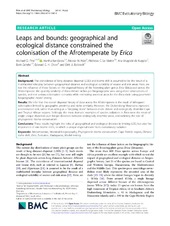| dc.contributor.author | Pirie, Michael David | |
| dc.contributor.author | Kandziora, Martha | |
| dc.contributor.author | Nürk, Nicolai | |
| dc.contributor.author | Le Maitre, Nicholas C. | |
| dc.contributor.author | Mugrabi de Kuppler, Ana | |
| dc.contributor.author | Gehrke, Berit | |
| dc.contributor.author | Oliver, Edward G.H. | |
| dc.contributor.author | Bellstedt, Dirk U. | |
| dc.date.accessioned | 2020-05-07T08:15:25Z | |
| dc.date.available | 2020-05-07T08:15:25Z | |
| dc.date.issued | 2019-12-05 | |
| dc.Published | Pirie MD, Kandziora, Nürk, Le Maitre NC, Mugrabi de Kuppler, Gehrke B, Oliver, Bellstedt DU. Leaps and bounds: geographical and ecological distance constrained the colonisation of the Afrotemperate by Erica. BMC Evolutionary Biology. 2019;19:222 | eng |
| dc.identifier.issn | 1471-2148 | |
| dc.identifier.uri | https://hdl.handle.net/1956/22114 | |
| dc.description.abstract | Background The coincidence of long distance dispersal (LDD) and biome shift is assumed to be the result of a multifaceted interplay between geographical distance and ecological suitability of source and sink areas. Here, we test the influence of these factors on the dispersal history of the flowering plant genus Erica (Ericaceae) across the Afrotemperate. We quantify similarity of Erica climate niches per biogeographic area using direct observations of species, and test various colonisation scenarios while estimating ancestral areas for the Erica clade using parametric biogeographic model testing. Results We infer that the overall dispersal history of Erica across the Afrotemperate is the result of infrequent colonisation limited by geographic proximity and niche similarity. However, the Drakensberg Mountains represent a colonisation sink, rather than acting as a “stepping stone” between more distant and ecologically dissimilar Cape and Tropical African regions. Strikingly, the most dramatic examples of species radiations in Erica were the result of single unique dispersals over longer distances between ecologically dissimilar areas, contradicting the rule of phylogenetic biome conservatism. Conclusions These results highlight the roles of geographical and ecological distance in limiting LDD, but also the importance of rare biome shifts, in which a unique dispersal event fuels evolutionary radiation. | en_US |
| dc.language.iso | eng | eng |
| dc.publisher | BMC | eng |
| dc.rights | Attribution CC BY | eng |
| dc.rights.uri | https://creativecommons.org/licenses/by/4.0 | eng |
| dc.title | Leaps and bounds: geographical and ecological distance constrained the colonisation of the Afrotemperate by Erica | eng |
| dc.type | Peer reviewed | en_US |
| dc.type | Journal article | en_US |
| dc.date.updated | 2020-01-10T13:10:17Z | |
| dc.description.version | publishedVersion | |
| dc.rights.holder | Copyright the authors | eng |
| dc.identifier.doi | https://doi.org/10.1186/s12862-019-1545-6 | |
| dc.identifier.cristin | 1758729 | |
| dc.source.journal | BMC Evolutionary Biology | |

